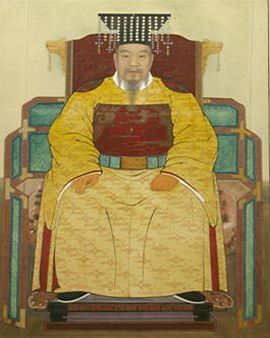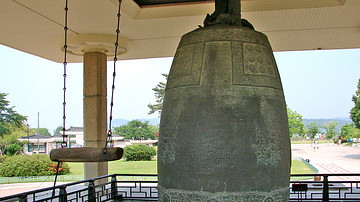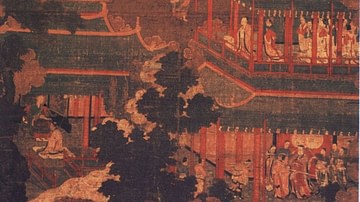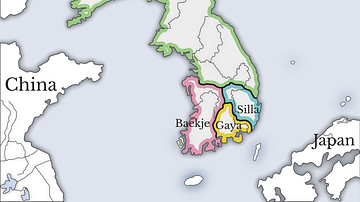
The Later Three Kingdoms period (889-935 CE) of ancient Korea saw a partial revival of the old three kingdoms which had dominated the peninsula from the 1st century BCE to the 7th century CE. After the Unified Silla kingdom had ruled Korea alone from 668 CE, it slowly began to decline and the power vacuum this created led to several rebellious states rising up and taking on the old historical names of Korea's ancient kingdoms. A messy period of alliances and in-fighting followed, but one state would once again establish a dominant position – Goryeo, itself named in homage to the earlier northern Goguryeo kingdom – and form a unified Korean state and a dynasty which would last for over 500 years.
The Fall of Silla
The Unified Silla Kingdom (668- 935 CE) had held sway over the Korean peninsula for three centuries, but the state was in a slow decline. The rigidity of its class structure based on the Bone rank system meant that few could rise above the position of their birth and ideas and innovation were stifled. The aristocracy began to resent the power and waste of the king, landowners resisted centralised control, and the peasantry grew more and more rebellious over the incessant taxes levied upon them. The state was falling apart from within.
The weakness of the central Silla government meant that local warlords and strongmen, always difficult to bring under state control at the best of times, now ruled their own territories as they pleased. Banditry swept across the peninsula with particularly infamous villains being Chongill, Kihwon, Yanggil, and a group known as the Red Pantaloons (Chokkojok).
Gyeon Hwon & Gung Ye
This period of political turmoil which turned into a free-for-all for control of Korea is referred to as the Later Three Kingdoms period (889-935 CE). Gyeon Hwon (867-936 CE), a peasant leader and Silla army officer, took advantage of the political unrest in 892 CE and made himself military governor of the city of Muju. By 900 CE Gyeon became more ambitious and, joining forces with the bandit Yanggil, formed a revival of the old Baekje (Paekche) kingdom in the south-west portion of the peninsula. He chose Wansan (modern Jeonju) as his capital.
Meanwhile, an aristocratic Buddhist monk leader, Gung Ye, declared a new Goguryeo state in the north in 901 CE, known as Later Goguryeo (Hugoguryo). Gung Ye was either the illegitimate son of king Kyongmun or king Honan depending on the account. He, too, had formed an alliance with Yanggil but proved rather more ruthless and killed the bandit, clearing the way to declare himself king in his own right. His capital was first at Songak (Gaesong) and then Cheorwon. He also twice changed the name of his kingdom – to Majin in 904 CE and Taebong in 911 CE – illustrative of his unstable character. One thing that never changed was Gung's hatred of Silla and his insistence that his subjects always refer to it as the 'nation of the damned.'
There then followed a protracted power struggle for control of the peninsula. Gyeon Hwon attacked Gyeongju, the Silla capital, in 927 CE, while Gung Ye's unpopular and fanatical tyranny led to his death at the hands of his people. Gung had become drunk on power and believed himself to be the Maitreya Buddha, spent his time composing sutras, dressed himself and his family in extravagant robes, and never went anywhere without an entourage of 200 monks chanting in his wake. He even claimed he had the power of mind-reading and used his 'skills' to purge his court of anyone he suspected of disloyal intentions. Gung was succeeded in 918 CE by his first minister, the able Wang Geon who probably had a hand in his hated predecessor's assassination. Wang had already distinguished himself as a naval commander, capturing several islands and blocking Baekje's trade with China and Japan. Wang selected the new name of Goryeo (Koryo) and moved the capital to Songak (modern Kaesong) where his father had long been a wealthy merchant and local headman.
Wang Geon's Unification of Korea
Later Baekje (Hubaekche) attacked the Silla kingdom in 920 and 924 CE. Silla, now the weakest of the three kingdoms and only controlling a small heartland in the deep south, responded by calling on Later Goguryeo for assistance. When Baekje attacked and sacked the Silla capital of Gyeongju in 927 CE, the Silla king Gyeongjae (r. 924-927 CE) was forced to commit suicide and a puppet ruler, Kim Pu installed in his place with the reign name of Gyeongsun. Wang responded by attacking the Later Baekje capital, which was now beset by leadership in-fighting. Gyeon Hwon then lost a battle at Geochang to a force led by Wang. Back at the Baekje capital, Gyeon faced a rebellion led by his son Singom, who, displeased that his father had favoured his younger brother as next in line for the throne, imprisoned Gyeon.
Wang was now in possession of most of Silla's territory, which he controlled via a new garrison outside Gyeongju, and his position as de facto ruler of Korea was recognised by the Tang dynasty of China in 932 CE. In 934 CE, after Wang's overwhelming victory over Baekje at Unju (Hongsong), refugees from the northern Manchurian state of Balhae (Parhae) felt the situation stable enough to return to Korea.
Gyeongsun surrendered and named Wang as his successor in 935 CE, and in the same year Gyeon, who had escaped to Goguryeo territory, appealed to his old enemy Wang for help to remove Singom. Gyeon led a Goguryeo army to Baekje, and the resulting civil war and death of both Singom and Gyeon in 936 CE, greatly weakened Baekje and allowed Wang to finally unify the country once again under the name of Goryeo, origin of today's name for Korea. Wang, posthumously given the title of Taejo of Goryeo or 'Great Founder,' established a dynasty which would rule Korea for the next five centuries.
This content was made possible with generous support from the British Korean Society.






